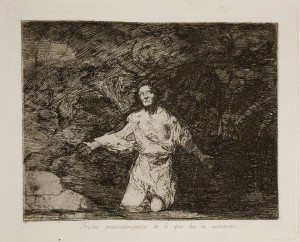 He worked clandestinely to document the atrocities of the war raging around him. Goya was serving as a court painter to the Spanish monarchy when the country was invaded by Napoleon. Although he was 62, nearly deaf and in poor health, he kept up his printmaking through the year-long starvation of Madrid when the city was under siege by French forces. The artist worked for the next ten years to create his subversive works until he began to run out of copper for plates.But before this shortage happened, Francisco de Goya amassed his secret collection of 80 aquatint etchings that stand as a sobering testament to the ravages of war. The images of Los Desastres de la Guerra depict an unromantic record of the scenes he saw around him as a result of this conflict, and the collection is grouped into three categories: war, famine, and political and cultural allegories.
He worked clandestinely to document the atrocities of the war raging around him. Goya was serving as a court painter to the Spanish monarchy when the country was invaded by Napoleon. Although he was 62, nearly deaf and in poor health, he kept up his printmaking through the year-long starvation of Madrid when the city was under siege by French forces. The artist worked for the next ten years to create his subversive works until he began to run out of copper for plates.But before this shortage happened, Francisco de Goya amassed his secret collection of 80 aquatint etchings that stand as a sobering testament to the ravages of war. The images of Los Desastres de la Guerra depict an unromantic record of the scenes he saw around him as a result of this conflict, and the collection is grouped into three categories: war, famine, and political and cultural allegories. Although Goya’s livelihood was earned primarily through painting portraits of nobility, he turned to the dark shadows and shades of etching for his documentary project. Mary Tartaro, interim director of the Natalie and James Thompson Gallery, remarks on the forcefulness of this exhibition: “It’s like when I viewed images of the Vietnam War on TV, war reporting that was so graphic and powerful.”
Although Goya’s livelihood was earned primarily through painting portraits of nobility, he turned to the dark shadows and shades of etching for his documentary project. Mary Tartaro, interim director of the Natalie and James Thompson Gallery, remarks on the forcefulness of this exhibition: “It’s like when I viewed images of the Vietnam War on TV, war reporting that was so graphic and powerful.”
Art historians are unclear what Goya’s ultimate intentions were for the etchings, but they were considered so incendiary that they weren’t published until 35 years after his death. Our only direct link to the painter’s thoughts are the captions he wrote for the prints, with titles like the straightforward Escapan entre las llamas (They escape among the flames) depicting men and women fleeing a burning city, to the enigmatic No quieren (They do not want to) showing an elderly woman preparing to stab a soldier who’s attacking a young woman. This latter print depicts a scene that afflicted many during Goya’s lifetime: women raped by the invading army.
 The San José community will experience Goya’s prints thanks to the combined efforts of several entities: the exhibition was curated by Janis Tomlinson from the University of Delaware; it’s on loan from Pomona College Museum of Art; and it will be displayed at our campus gallery thanks to the generous endowment of Natalie and James Thompson. On November 3, during the closing week of the show, the College’s dance program will perform a choreographed response to the artist’s vision.
The San José community will experience Goya’s prints thanks to the combined efforts of several entities: the exhibition was curated by Janis Tomlinson from the University of Delaware; it’s on loan from Pomona College Museum of Art; and it will be displayed at our campus gallery thanks to the generous endowment of Natalie and James Thompson. On November 3, during the closing week of the show, the College’s dance program will perform a choreographed response to the artist’s vision.
These devastating images created by Goya two centuries ago serve as a powerful reminder to current generations about the price of war.
Los Desastres de la Guerra is on display at the Natalie and James Thompson Gallery September 1 through November 6; the exhibition is free and open to the public. For more details visit the gallery’s website.


